人教版四年级英语下册Unit6 Shopping第四课时教案
人教PEP版英语四年级下册Unit 6《Shopping》(let’s talk PartB)教案

人教PEP版英语四年级下册Unit 6《Shopping》(let’s talk PartB)教案一. 教材分析《人教PEP版英语四年级下册Unit 6 Shopping》主要让学生学会在购物场景中进行简单的交流。
通过学习,学生能够听懂、会说、会读关于购物的话题,并能够运用所学知识进行简单的购物交流。
本课的主要内容是学习如何询问价格和回答价格,以及如何表达喜好和选择。
二. 学情分析四年级的学生已经具备了一定的英语基础,对于日常生活中的基本交流已经有了一定的掌握。
但是,学生在语言表达的准确性和语言运用的灵活性方面还存在一定的困难。
因此,在教学过程中,需要注重学生的语言输入和输出的准确性,以及培养学生运用英语进行交流的能力。
三. 教学目标1.知识目标:学生能够听懂、会说、会读关于购物的话题,掌握询问价格和回答价格的句型,以及表达喜好和选择的句型。
2.能力目标:学生能够在购物场景中进行简单的交流,能够运用所学知识进行购物活动。
3.情感目标:培养学生热爱生活,乐于交流的态度。
四. 教学重难点1.重点:学生能够听懂、会说、会读关于购物的话题,掌握询问价格和回答价格的句型,以及表达喜好和选择的句型。
2.难点:学生能够在购物场景中进行自由的交流,能够运用所学知识进行购物活动。
五. 教学方法采用情境教学法、交际法和生活教学法。
情境教学法可以帮助学生更好地理解和学习语言,交际法可以提高学生的语言运用能力,生活教学法可以激发学生的学习兴趣。
六. 教学准备1.教师准备:准备好相关的教学材料,如PPT、图片、实物等。
2.学生准备:学生需要预习相关的内容,熟悉基本的购物词汇。
七. 教学过程1.导入(5分钟)教师通过播放一首关于购物的歌曲,引起学生的兴趣,然后向学生提问:“你们喜欢购物吗?为什么?”让学生发表自己的看法,从而引出本课的主题。
2.呈现(10分钟)教师通过PPT展示本课的主要内容,包括词汇、句型等,同时进行讲解和示范。
人教PEP版英语四年级下册Unit6《Shopping》(story)说课稿
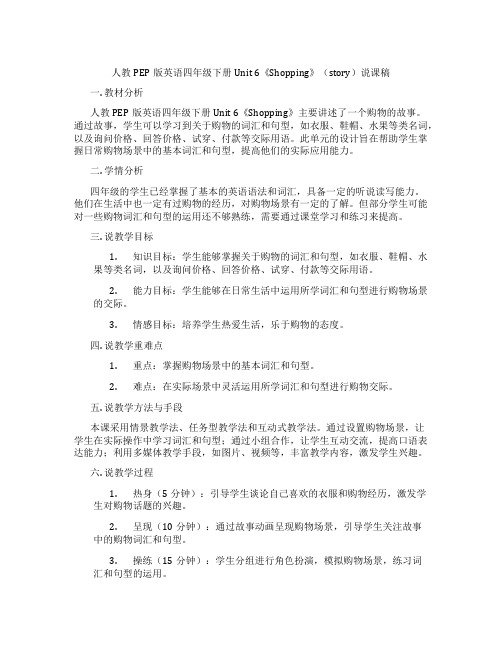
人教PEP版英语四年级下册Unit 6《Shopping》(story)说课稿一. 教材分析人教PEP版英语四年级下册Unit 6《Shopping》主要讲述了一个购物的故事。
通过故事,学生可以学习到关于购物的词汇和句型,如衣服、鞋帽、水果等类名词,以及询问价格、回答价格、试穿、付款等交际用语。
此单元的设计旨在帮助学生掌握日常购物场景中的基本词汇和句型,提高他们的实际应用能力。
二. 学情分析四年级的学生已经掌握了基本的英语语法和词汇,具备一定的听说读写能力。
他们在生活中也一定有过购物的经历,对购物场景有一定的了解。
但部分学生可能对一些购物词汇和句型的运用还不够熟练,需要通过课堂学习和练习来提高。
三. 说教学目标1.知识目标:学生能够掌握关于购物的词汇和句型,如衣服、鞋帽、水果等类名词,以及询问价格、回答价格、试穿、付款等交际用语。
2.能力目标:学生能够在日常生活中运用所学词汇和句型进行购物场景的交际。
3.情感目标:培养学生热爱生活,乐于购物的态度。
四. 说教学重难点1.重点:掌握购物场景中的基本词汇和句型。
2.难点:在实际场景中灵活运用所学词汇和句型进行购物交际。
五. 说教学方法与手段本课采用情景教学法、任务型教学法和互动式教学法。
通过设置购物场景,让学生在实际操作中学习词汇和句型;通过小组合作,让学生互动交流,提高口语表达能力;利用多媒体教学手段,如图片、视频等,丰富教学内容,激发学生兴趣。
六. 说教学过程1.热身(5分钟):引导学生谈论自己喜欢的衣服和购物经历,激发学生对购物话题的兴趣。
2.呈现(10分钟):通过故事动画呈现购物场景,引导学生关注故事中的购物词汇和句型。
3.操练(15分钟):学生分组进行角色扮演,模拟购物场景,练习词汇和句型的运用。
4.扩展(10分钟):学生分组讨论,思考购物场景中可能遇到的交际问题,并尝试解决。
5.巩固(5分钟):全体学生进行购物场景的互动游戏,加深对词汇和句型的记忆。
人教PEP四年级英语下册教案Unit6 Shopping Part B教案4

Unit 6 Shopping Part B 教案I. On Teaching MaterialThis lesson is about asking the price and inquiring the clothes size. It is a dialogue about a shopping topic. Such a topic is related to daily life. So, it is helpful to raise learning interest of students and to improve their spoken English. It can also help them review the learned knowledge. II. On Teaching Aims1. Knowledge aimsThe students can hear, speak and read the main sentence patterns ‘A pair of … for …’, ‘How much are they?’, ‘What size?’, ‘We’ll take them’.The students can understand and read the conversation of the lesson.2. Ability aimsThe students can use the patterns to express their thoughts in the proper scene, and further improve their language ability of ‘shopping’.3. Emotion aimsBy completing the tasks, the students can increase their interest and set up self-confidence in language study.4. Key pointsMake students grasp and use the main sentence patterns: A pair of … for …; What size? How much are they? We’l l take them.5. Difficult pointsThe students can use the words and patterns to describe the price and size of the clothes in the proper scene.III. On Teaching & Learning Methods1. Analysis of teaching methods(1) Communicative teaching method(2)Task-based teaching method2. Teaching aidsCAI and Tape recorder3. Learning methodsLet students study in a relaxing and agreeable atmosphere. Let students obtain the knowledge actively by co-operative study. Let students communicate with each other and adopt competition methods to develop students’ interest in English.IV. On Teaching ProceduresStep 1 Warm-upSing a song: The coat in the windowPurpose: This step is employed to form a better situation for the students by singing. They will come into the real surrounding of English learning. And it can also help them review the sentence pattern ‘How much is …?’ for the next step.Step 2 Presentation1. Looking for CinderellaWith the help of CAI to show some pictures of ‘Cinderella’, present a crystal shoe that she lost, and establish a scene of ministers looking for the proper size everywhere. Through the role playing, guide the students to make questions and answers by using the sentence patterns ‘What size do you wear?’ ‘Size …’.Purpose:CAI can provide a real situation to understand the meaning of the pattern and to arouse the students’ interest in the English learning.2. Guessing gamePresent a big cabinet with various shoes, and introduce the sentence pattern ‘A pair of …for…’. After the students are familiar with it, present the other sentence pattern ‘How much are they?’, and guide the students to make the answer ‘They are…’. Ask the students to guess the price of shoes in the cabinet, and display them.Purpose: The game can avoid the lifelessness and boredom from the pure machine drills. Step 3 Practice1. After the teacher’s brief introduction to the dialogue, ask students to listen to the tape of the dialogue with their books closed. And then ask the students to answer two simple questions: What size dose John wear? How much are they?Purpose: This step is employed to make the students get the general idea of the dialogue and practise their listening ability.2. Ask the students to read after the tape, and pay attention to their pronunciation and intonation.3. Ask them to practise in pairs by reading the dialogue aloud. And then let some pairs try to act it out.Purpose: By this step, it achieves the teaching aim of understanding and reading the dialogue of this lesson.Step 4 Consolidation & extensionFather’s DayShow some pictures, including shoes, clothes, fruits, and so on, divide the class into groups and play roles, and suppose that everyone has money, so that they can choose and buy the gifts for fathers. And then make some similar dialogues. (According to sentence patterns: What size? How about this pair? How much are they? We’ll take them.)Purpose:This step is employed to create a language environment to develop students’ abilities of communication and co-operation.Step 5 Homework1. Do the exercises in the activity book.2. Interview their parents and ask the price and size of their clothes.Purpose:It is necessary for the students to do some extensive exercises after class to consolidate the knowledge they learned.。
最新人教pep版《小学英语四年级下册Unit 6 shopping(全单元教学设计)》精品优秀打印版整单元每一课教案
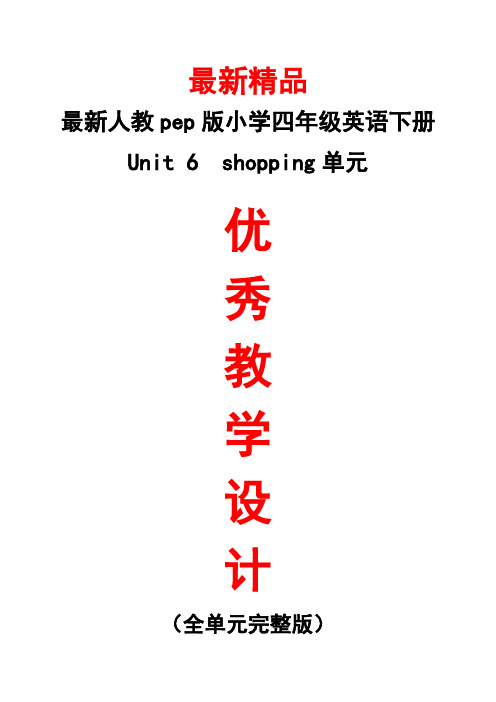
5,please.
实际生活中。
S1:Of course./Sure.Here you are.
S3:Are they OK?
S2: No,they are too big. /They are just right.
作业 1.背诵 Let’s talk。
板书
Unit 6 Shopping
设计 2.和同桌之间演练对话。
让学生结束上
Shake your shoulders,shua shua shua. (上下抖动肩膀) Shake 节课的紧张,
your hands,clap clap clap.(甩甩手,拍三下)
并集中其注意
Shake your hip,pia pia pia.(扭扭屁股,打三下)
力。
Shake your feet,dong dong dong.(抖抖脚,跺三下)
设计 Can I help you?
Can I try them on?
Size 6,please.
第三课时
教学过程
批注
一、Warm-up & Revision
1.Listen and chant.
2.让学生将之前学过的 Let’s spell 读一读。
二、Presentation & Practice
T:Can I help you?
语,有利于学
S1:Yes.The sunglasses are very nice.Can I try them on? 生理解对话内
T:Sure.Here you are.
容并且培养学
6.让学生两人一组演练对话。
生英语语感。
7.播放 Let’s learn 部分的录音,学生跟读。
人教PEP版英语四年级下册Unit6《Shopping》(let’slearnPartA)教学设计
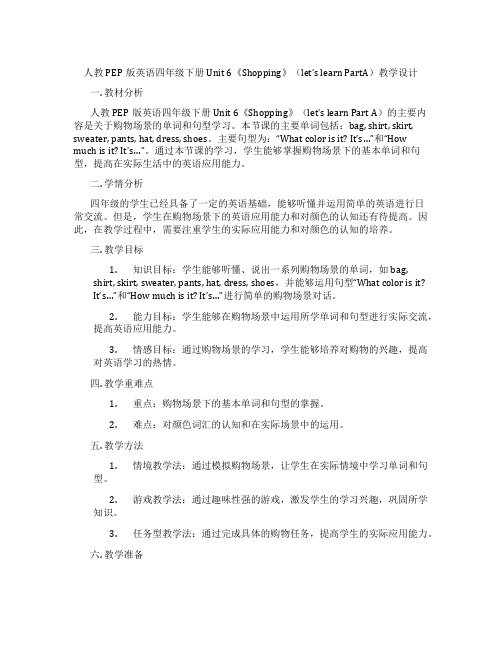
人教PEP版英语四年级下册Unit 6《Shopping》(let’s learn PartA)教学设计一. 教材分析人教PEP版英语四年级下册Unit 6《Shopping》(let’s learn Part A)的主要内容是关于购物场景的单词和句型学习。
本节课的主要单词包括:bag, shirt, skirt, sweater, pants, hat, dress, shoes。
主要句型为:“What color is it? It’s…”和“How much is it? It’s…”。
通过本节课的学习,学生能够掌握购物场景下的基本单词和句型,提高在实际生活中的英语应用能力。
二. 学情分析四年级的学生已经具备了一定的英语基础,能够听懂并运用简单的英语进行日常交流。
但是,学生在购物场景下的英语应用能力和对颜色的认知还有待提高。
因此,在教学过程中,需要注重学生的实际应用能力和对颜色的认知的培养。
三. 教学目标1.知识目标:学生能够听懂、说出一系列购物场景的单词,如bag,shirt, skirt, sweater, pants, hat, dress, shoes,并能够运用句型“Wh at color is it?It’s…”和“How much is it? It’s…”进行简单的购物场景对话。
2.能力目标:学生能够在购物场景中运用所学单词和句型进行实际交流,提高英语应用能力。
3.情感目标:通过购物场景的学习,学生能够培养对购物的兴趣,提高对英语学习的热情。
四. 教学重难点1.重点:购物场景下的基本单词和句型的掌握。
2.难点:对颜色词汇的认知和在实际场景中的运用。
五. 教学方法1.情境教学法:通过模拟购物场景,让学生在实际情境中学习单词和句型。
2.游戏教学法:通过趣味性强的游戏,激发学生的学习兴趣,巩固所学知识。
3.任务型教学法:通过完成具体的购物任务,提高学生的实际应用能力。
六. 教学准备1.教学课件:制作精美的教学课件,包括单词图片、动画和购物场景的视频等。
人教PEP版英语四年级下册Unit 6《Shopping》(let’s learn PartB)教案
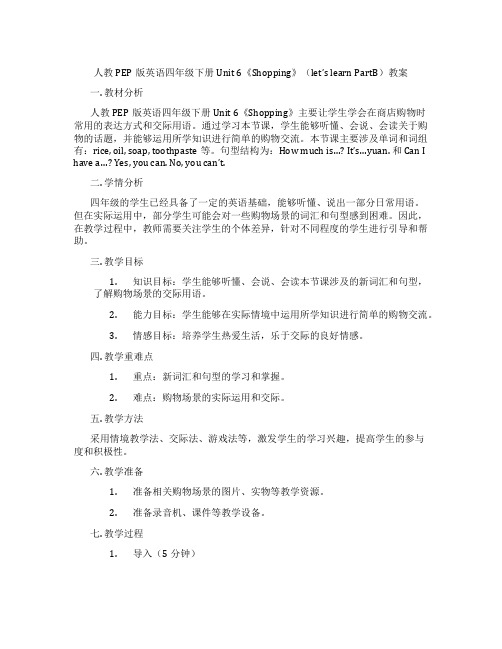
人教PEP版英语四年级下册Unit 6《Shopping》(let’s learn PartB)教案一. 教材分析人教PEP版英语四年级下册Unit 6《Shopping》主要让学生学会在商店购物时常用的表达方式和交际用语。
通过学习本节课,学生能够听懂、会说、会读关于购物的话题,并能够运用所学知识进行简单的购物交流。
本节课主要涉及单词和词组有:rice, oil, soap, toothpaste等。
句型结构为:How much is…? It’s…yuan. 和 Can I have a…? Yes, you can. No, you can’t.二. 学情分析四年级的学生已经具备了一定的英语基础,能够听懂、说出一部分日常用语。
但在实际运用中,部分学生可能会对一些购物场景的词汇和句型感到困难。
因此,在教学过程中,教师需要关注学生的个体差异,针对不同程度的学生进行引导和帮助。
三. 教学目标1.知识目标:学生能够听懂、会说、会读本节课涉及的新词汇和句型,了解购物场景的交际用语。
2.能力目标:学生能够在实际情境中运用所学知识进行简单的购物交流。
3.情感目标:培养学生热爱生活,乐于交际的良好情感。
四. 教学重难点1.重点:新词汇和句型的学习和掌握。
2.难点:购物场景的实际运用和交际。
五. 教学方法采用情境教学法、交际法、游戏法等,激发学生的学习兴趣,提高学生的参与度和积极性。
六. 教学准备1.准备相关购物场景的图片、实物等教学资源。
2.准备录音机、课件等教学设备。
七. 教学过程1.导入(5分钟)利用图片引入购物场景,激发学生的学习兴趣。
引导学生用中文谈论购物场景,为过渡到英语学习做好铺垫。
2.呈现(5分钟)教师展示课件,呈现本节课的新词汇和句型。
用中文解释词汇和句型的含义,然后用英语呈现,让学生听懂、理解并模仿。
3.操练(10分钟)学生分组进行角色扮演,模拟购物场景。
教师巡回指导,纠正发音,帮助学生熟练掌握句型和词汇。
最新人教版四年级下册英语教案Unit 6 Shopping
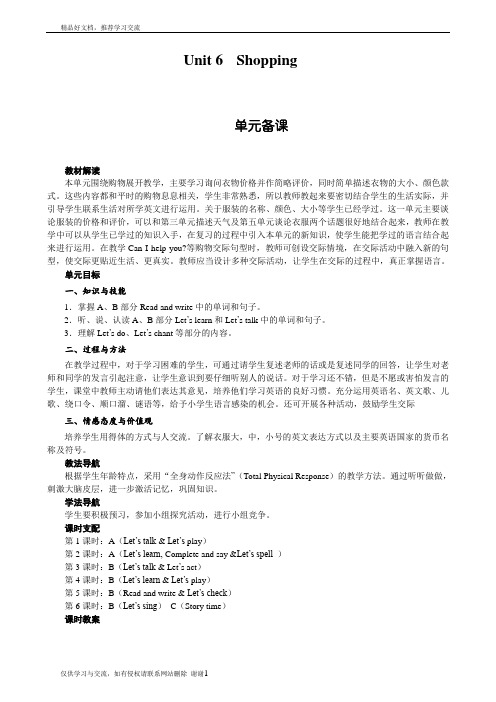
Unit 6Shopping单元备课教材解读本单元围绕购物展开教学,主要学习询问衣物价格并作简略评价,同时简单描述衣物的大小、颜色款式。
这些内容都和平时的购物息息相关,学生非常熟悉,所以教师教起来要密切结合学生的生活实际,并引导学生联系生活对所学英文进行运用。
关于服装的名称、颜色、大小等学生已经学过。
这一单元主要谈论服装的价格和评价,可以和第三单元描述天气及第五单元谈论衣服两个话题很好地结合起来,教师在教学中可以从学生已学过的知识入手,在复习的过程中引入本单元的新知识,使学生能把学过的语言结合起来进行运用。
在教学Can I help you?等购物交际句型时,教师可创设交际情境,在交际活动中融入新的句型,使交际更贴近生活、更真实。
教师应当设计多种交际活动,让学生在交际的过程中,真正掌握语言。
单元目标一、知识与技能1.掌握A、B部分Read and write中的单词和句子。
2.听、说、认读A、B部分Let’s learn和Let’s talk中的单词和句子。
3.理解Let’s do、Let’s chant等部分的内容。
二、过程与方法在教学过程中,对于学习困难的学生,可通过请学生复述老师的话或是复述同学的回答,让学生对老师和同学的发言引起注意,让学生意识到要仔细听别人的说话。
对于学习还不错,但是不愿或害怕发言的学生,课堂中教师主动请他们表达其意见,培养他们学习英语的良好习惯。
充分运用英语名、英文歌、儿歌、绕口令、顺口溜、谜语等,给予小学生语言感染的机会。
还可开展各种活动,鼓励学生交际三、情感态度与价值观培养学生用得体的方式与人交流。
了解衣服大,中,小号的英文表达方式以及主要英语国家的货币名称及符号。
教法导航根据学生年龄特点,采用“全身动作反应法”(Total Physical Response)的教学方法。
通过听听做做,刺激大脑皮层,进一步激活记忆,巩固知识。
学法导航学生要积极预习,参加小组探究活动,进行小组竞争。
人教PEP四年级下册英语Unit6 Shopping教案 (4)

四年级下册英语教案1.能听、说、认、读单词:nice,cheap,pretty,expensive。
2.能运用句子:It’s cheap/ pretty/expensive/nice来描述价格和外观。
3.能完成“Read and write ”相应的练习,会用“They are…”来描述价格。
4.能完成“Let’s play”。
描述衣物的四个形容词以及能运用It’s cheap/pretty/expensive/nice来描述衣物价格和颜色。
expensive的书写和发音。
单词卡片,衣物,教学光盘。
Step 1:Warm-up①全班同学齐唱本单元歌《How much is that doggie in thewindow?》。
②教师展示一些衣物和学生Free talk,一人扮演售货员,一人扮演顾客。
教师为售货员,学生为顾客:T:Can I help you?S:Yes,That skirt/dress/hat is very nice/pretty.T:Yes,it is.S:How much is it?T:It’s …S:That’s /It’s expensive.价格。
Step 2:PresentationT:What’s this?S:It’s a shirt.How much is it?T:15yuan. S:It’s cheap. 引出单词“cheap”。
That shirt is cheap.教师展示另一件较贵的衣服,学生问,How much is it?T:It’s 450 yuan. S:It’s too expensive. 巩固单词“expensive”。
③“How about this one?”教师展示一件红色的连衣裙,学生感叹:Wow!it’s very pretty.”引出单词“pretty”。
Look at that hat.Is it nice?”学生回答:“Yes,it is.It’s nice.”。
- 1、下载文档前请自行甄别文档内容的完整性,平台不提供额外的编辑、内容补充、找答案等附加服务。
- 2、"仅部分预览"的文档,不可在线预览部分如存在完整性等问题,可反馈申请退款(可完整预览的文档不适用该条件!)。
- 3、如文档侵犯您的权益,请联系客服反馈,我们会尽快为您处理(人工客服工作时间:9:00-18:30)。
Unit 6 Shopping
杨家小学郭万玉
概述:
PEP小学英语四年级下册Unit 6 Shopping本单元共需六个课时,本单元围绕购物展开教学,主要学习询问衣物价格并作简略评价,同时简单描述衣物的大小、颜色款式,可以和第三单元描述天气及第五单元谈论衣服两个话题很好的结合起来,教师在教学中可以从学生已学过的知识入手,在复习的过程中引入本单元的新知识,使学生能把学过的语言结合起来进行运用。
在教学Can I help you?等购物交际句型时,教师可创设交际情境,在交际活动中融入新的句型,使交际更贴近生活,更真实。
本节课是第四课时,在课堂教学中,教师要使教学内容生活化,结合学生的实际情境,使学生口语练习生活化,交际化,从而达到学以致用的目的。
设计理念:
在跨越式理论指导下,以言语交际为中心,借助现代信息技术,努力为学生创设理想的英语学习环境,提供丰富的网络资源,倡导体验、实践、参与、交流与合作的学习方式。
倡导任务型教学,把语言综合运用能力的培养落实在教学过程中。
面向全体学生,突出“以人为本”的素质教育理想,使语言教学的过程同时成为提高人文素养、增强实践能力、培养创新精神的过程。
教学目标:
1.知识目标
A、听懂会说:“Can I help you? How much is this skirt? It's very pretty. That's expensive. It's too expensive.”
B、能在实际的情景中运用进行实际交际。
2.能力目标
A能将所学词汇运用到交际中。
B、能根据具体的情景运用所学知识进行对话,培养学生的交际能力
3.情感目标
A.激发学生的英语学习兴趣,培养良好的英语学习习惯。
B.培养孩子购物要节约的观念。
学情分析:
由于学生是四年级学生参加跨越式教学已经有三学期多了,他们已经适应了跨越式课堂模式,听说能力都比较强。
乐于感知,模仿习得英语。
学生
对数字在去年有所学习,所以本节课巩固旧知的同时进一步拓展与话题有关
的更多知识,来满足学生对知识的所需。
教学重、难点:
教学重点:
句型:Can I help you? How much is this skirt? It's very pretty. That's expensive. It's too expensive.
教学难点:
对新词的读音的指导和规范,如:“eighty-nine dollars.”
教学策略:
由于四年级学生已学习英语三学期多了,读与说的能力相对较好,因此
在教学过程中采用语言交际的教学策略,通过角色扮演、情景创设、教室内
真实的辅助性教学资源提供等,多种方式,激发学生学习积极性,帮助学生领
会对话内容,提高学生的语言交际能力。
教具准备:
1.教师自制PPT
2.跨越式课题组提供的拓展资源。
3.教学挂图
教学过程:
一、Warm-up/Revision (5minutes)
1、Let’s chant
【设计意图:让学生吟唱熟悉的调子,既能激发学生的兴趣,又能营
造英语氛围帮助学生进入学习英语的环境中。
】
2、Free talk.(划线单词可以替换)
A: Whose … are these?
B: They are ×××’s
A: What colour are they?
B: They are …
A: Do you like the …?
B: Yes, I do./No, I don’t.
Practice in pairs.
One or two group show us.
【设计意图:通过演唱歌曲、对话练习热身导入,使学生在与老师和伙
伴的互动中,迅速进入到课堂学习中,即复习了颜色的单词,又为新知的学
习做好了铺垫。
】
二、Presentation(15minutes)
1、教师通过课件展示各种衣物。
2、教师和孩子们进行对话的交流
T: Look at this shirt .It’s nice.
S: Yes, it’s pretty.
T: How much is it?
S (请一个孩子走到背面翻出价格)It’s one hundred yuan . It’s too expensive.
3、教师播放课件,让孩子观看故事,理解内容。
4、再看一边,边看边模仿故事中人物的语气说一说。
5、分角色给课件配音,小组练习和表演。
6、Model work,pair work
A: Can I help you ?
B: Yes,how much is this skirt?
A: It’s...
B:It’s too expensive.
A:How do you like this skirt?
B: It’s very pretty. How much is it ?
A: It’s ...
B: I’ll take it .
【设计意图:通过分层的教学和相对应的游戏让同学们在乐中学,学中乐,从而激发学生学习的积极性。
】
三、Extending reading(10minutes)
总体介绍:有四篇听读材料,播放拓展资源,对所学新知进行巩固,同时顺势拓展知识,让学生获取更多的知识。
1、听1-4后回答问题:What colour jacket does the boy like ?
2、听r-2reading1后获取词汇:vest.
3、听d1-2.扩展词汇:cheap.
4、听d1-1后后让学生获取:buy something for ...
【设计意图:让学生听读与课本内容相关的短文,大信息量输入,丰富学生的语言,在语境中体会、理解新知。
培养学生自主听读的能力及语感。
通过听后反馈信息,在交流中进一步学习拓展句型。
】
四、Cooperation and making dialogues(8minutes)
T:“Look at this shop, there are so many clothes there, now please talk with your partners”
(1) Model (2) Pair work (3) Show
A: Can I help you?
B: Yes, these … are pretty. Can I try them on?
A: Of course. Here you are.
B: Oh, this is \they are pretty.
A: How much is it\are they …?
B: They’re...yuan\It’s ...yuan.It’s too expensive
A: I want to buy a vest for ...
B : This way ,please.
【设计意图:此环节是对学生听读情境对话的反馈和运用,同时也是在语言输入的基础上为学生提供语言输出的机会,在老师的示范和引导下进行对话,培养学生灵活运用语言的能力。
既能落实课标的要求,又能实现语言的迁移运用。
】
五、Summary(1minuters)
What did you learn?
【设计意图:引导学生总结本课时的教学重点,加深了学生对所学知识的印象。
】
六、Homework(1minutes)
听第61页的Let’s talk 部分的录音,读给同伴、朋友或家长听
【设计意图:通过口头和书面作业巩固本节课知识,培养学生良好的英语学习习惯。
】
板书设计:
Unit 6 Shopping
How much is this skirt ?
It’s ....yuan
It’s too expensive
教学反思:
首先,让学生Let’s chant,激发了学生的好奇心,调动了他们的积极性;以此保持了他们学习英语的兴趣,给学生提供了一个有趣、轻松、活泼、竞争的氛围去交际。
但是大多数学生对expensive的发音有误,新授课部分花的时间比较多,以至于拓展听读部分预设的部分没有完成,争取下节课老师引导多点少讲点,让孩子们真正成为课堂的中心。
